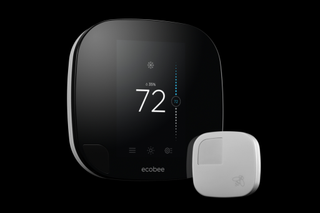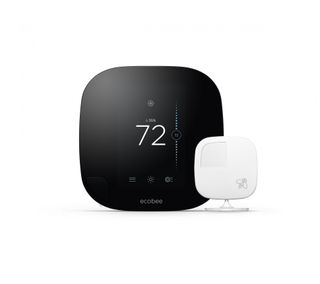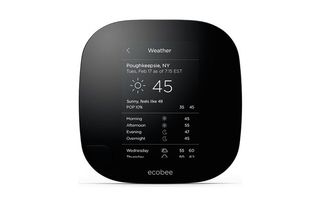Ecobee3 Thermostat Review
A remote sensor lets the Ecobee3 smart thermostat monitor the temperature in more than one room in your house.
Why you can trust Tom's Guide

My bedroom is a lot colder than my living room, even though it's just steps away. And, because my thermostat is located closer to my living room, as soon as it senses that my abode has warmed to 65 degrees, it shuts off the heat, leaving me shivering under my covers. The Ecobee3 thermostat has a clever solution to that problem: A remote wireless sensor that measures the temperature and communicates back to the base unit, telling it when it's hot or cold enough. But there's more to the $241 Ecobee3 than just that feature -- including smart home integration -- that makes it my favorite thermostat to date.
Editor's Note: This review was first updated on August 25 after we tested the updated Ecobee3 with Apple HomeKit functionality. It was later updated on Feb. 16, 2016 to add the fact that it also works with the Amazon Echo.
Design
While not as classically minimalist as the circular Nest Learning Thermostat, the Ecobee3 has a modern look that's just as attractive. Square with rounded corners, the face of the 3.9 x 3.9-inch Ecobee is glossy black plastic, with a 3.5-inch QVGA touch screen in the middle. In the lower left corner, a small wedge-shaped section conceals a motion sensor.

Like the base unit, the Ecobee3 remote sensor is square with rounded corners, but measures a much smaller 1.7 x 1.7 x 0.8 inches, and is all white. This, too, has a small motion sensor, which detects when you're in a room.
Setup
Unlike the Nest and the Honeywell Lyric, both of which have built-in batteries, the Ecobee3 draws its power from your HVAC system's Common wire (C-wire). According to Ecobee, this is a more reliable method than its competitors', which draw power from the wires used to control the heater and air conditioner, but don't provide as steady a current.
For those who don't have a C-wire running from their furnace to their thermostat, Ecobee includes a Power Extender Kit that connects to your furnace. My situation was somewhat unique; although I didn't have a C-wire running to my thermostat, I couldn't easily install the adapter, because my apartment has a commercial-grade furnace. I had a technician from All City Heating and Cooling in Jersey City install a C-wire. After examining my unit and the Power Extender Kit, the technician said that the kit should be fairly easy for homeowners to install in residential furnaces.
Regardless, if you're uneasy about installing the Ecobee yourself, the company provides a link on its site to get a quote for a professional installation.

After it's installed, the rest of the setup procedure involves telling the Ecobee what kind of heating or cooling system you have, entering your Wi-Fi password, and setting your location. In all, this part of the procedure took about 5 minutes, and was as simple as the Nest's setup program.
MORE: Best Smart Home Gadgets
The Ecobee comes with one wireless sensor, which is powered by a CR2032 coin-cell battery; the company says it should last about 4 years. When the battery runs low, you'll receive an alert.
If you've got a larger place than my one-bedroom apartment, the Ecobee can support up to 32 wireless sensors ($79 for a package of two). However, those with McMansions take note: The sensors have a range of only 45 feet.
Interface
If you've used a smartphone, the layout and operation of the Ecobee's interface will feel instantly familiar. In its inactive state, the Ecobee displays the current temperature inside your home in big white numbers and an icon showing the local weather conditions.

When you walk in front of the thermostat, activating its motion sensor, the display changes to show a line of dots running vertically down the right side. The top half of the dots are blue, and the lower half are orange. Within each half is a number in a small circle; these represent the desired temperatures when the system is in heating or cooling mode. If you want to temporarily change either setting, simply hold your finger on the number and drag it up or down.

It's very minimalist -- except for the line of dots, all the numbers are in white, with a black background. Still, in some ways, it felt even easier to use and understand the Ecobee's controls than the Nest.
Along the bottom of the display are three icons. The one on the left opens a menu where you can adjust settings, set a schedule, reminders and vacation modes. The middle icon reveals a weather forecast for the week, and the right icon lets you activate Home or Away modes. It's a handy shortcut.
Performance
The Ecobee3 performed very well, responding instantly to my inputs, whether they were on the base unit or from my smartphone.
You can set the Ecobee to turn on your HVAC system based on the temperature in the base unit. Or, by activating Follow Me, Ecobee will turn on the system based on the average temperature from selected sensors that have recently detected motion. If you've got a cold room in the house, this is the setting you'll want to use. I especially like that it's only active when it detects movement in one of the remote sensors. That way, you're not paying to heat a room you're not using.

Of course, when I set the thermostat to remain on until all the rooms were 65 degrees, my living room was noticeably warmer. Keeping the heat (or air conditioner) on longer will also drive up your utility bill.
Another clever feature is the Smart Home/Away setting. When active, the Ecobee will override the Away setting if it detects someone is home. Fortunately, my 18-pound cat Walter was too small to trigger the thermostat.
MORE: Best Robot Vacuums
App and Web Portal
I really like that Ecobee's iOS app (also available for Android) is nearly identical to that of the thermostat's interface. Curiously, you can only activate Follow Me from the base unit, and not the app. Still, any changes I made using the app were instantly relayed to the base unit.

Ecobee's Web portal also lets you monitor and change settings on the thermostat, but adds an extra wrinkle. A tab labeled Home IQ allows you to see detailed information about when your heating and cooling system was on, and the environmental factors that triggered it. For example, I could see that, on average, the heat was on longer on colder days, as well as when the heating system was active.
Connected Home
Any Wi-Fi-enabled thermostat worth its salt should be able to connect to smart home systems. While not as robust as the Nest, which has its own ecosystem and a sizable head start with connected devices, the Ecobee can talk to SmartThings, Control4 and Vera smart home systems, and has an open API, so more partnerships could be in the works. You can also control it with your voice using either Siri (via Apple HomeKit) or the Amazon Echo.
The Ecobee also works with IFTTT (If This, Then That). So, for example, you can have it automatically turn on its Home setting when you enter an area.
Apple HomeKit Integration
The Ecobee3 is one of the first smart-home devices compatible with Apple's HomeKit, which allows you to control the thermostat from your iPhone or iPad using Siri.
Those who purchased an older Ecobee3 and want to use HomeKit features will have to upgrade to a newer HomeKit-compatible Ecobee3; unfortunately, this will require purchasing a new Ecobee3 at its full $249 price.
Setting up the HomeKit-compatible Ecobee3 involves an extra step from the installation described above. In the mobile app, you select the option to pair a HomeKit-enabled thermostat. If the app sees the thermostat on your network, it will appear on your phone. Then, a code will appear on the screen of the Ecobee. Enter that into the app, and the Ecobee will then be added to your HomeKit portfolio of devices.
If you want to use Siri to control your Ecobee3 away from home, you'll also need an AppleTV (Generation 3 or later) running version 7.0 or higher.
Using Siri to Change the Temperature
Once set up, you can use Siri to change the temperature in your home, whether you're there or not. It was nice to be able to say such commands as "Set my thermostat to 74 degrees" and have my air conditioner turn on immediately. If I was out of my home, I could also say, "Enable Ecobee3 Away," and the thermostat would change its mode accordingly. You can also ask Siri what the current temperature is inside your home. A list of commands can be found here.
Unfortunately, when using HomeKit, Auto mode -- the ability to automatically switch between heating and cooling -- is not available, so you’ll need to remember to do this yourself when summer ends.
Overall, I found the HomeKit-enabled Ecobee3 to be a nice extra feature. When more HomeKit-enabled devices are available, you will be able to create scenarios that will shut off the lights, lock the doors, and change the temperature when you leave your home. Until then, if you already own a non-HomeKit-enabled Ecobee3, it's probably not worth the upgrade.
Verdict
As much as I loved the Nest, it was tough getting my bedroom to a temperature I liked. The $241 Ecobee3 solves that problem well, making it my current favorite smart home thermostat. It has a modern look, an easy-to-use interface and useful features. While the installation was a little complex, I think mine was a special case; homeowners with a little DIY know-how should be able to install it themselves.
Taking nothing from the Nest Learning Thermostat, which has a great design and works with a larger number of smart home devices, I prefer the Ecobee3 for the simple reason that it did a better job of keeping me warm at night. Isn't that what a thermostat is supposed to do?
Sign up to get the BEST of Tom’s Guide direct to your inbox.
Upgrade your life with a daily dose of the biggest tech news, lifestyle hacks and our curated analysis. Be the first to know about cutting-edge gadgets and the hottest deals.

Michael A. Prospero is the U.S. Editor-in-Chief for Tom’s Guide. He oversees all evergreen content and oversees the Homes, Smart Home, and Fitness/Wearables categories for the site. In his spare time, he also tests out the latest drones, electric scooters, and smart home gadgets, such as video doorbells. Before his tenure at Tom's Guide, he was the Reviews Editor for Laptop Magazine, a reporter at Fast Company, the Times of Trenton, and, many eons back, an intern at George magazine. He received his undergraduate degree from Boston College, where he worked on the campus newspaper The Heights, and then attended the Columbia University school of Journalism. When he’s not testing out the latest running watch, electric scooter, or skiing or training for a marathon, he’s probably using the latest sous vide machine, smoker, or pizza oven, to the delight — or chagrin — of his family.
